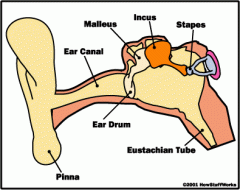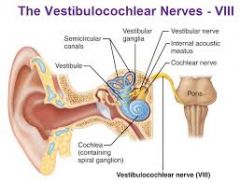![]()
![]()
![]()
Use LEFT and RIGHT arrow keys to navigate between flashcards;
Use UP and DOWN arrow keys to flip the card;
H to show hint;
A reads text to speech;
48 Cards in this Set
- Front
- Back
|
the external ear canal is through what bone? |
the temporal bone
|
|
|
the ear canal is 2–3cm long, what are the different parts of it?
|
lateral 1/3rd: cartilaginous with auricular skin |
|
|
What is the lining of the tympanic membrane? |
externally: lined with thick skin
internally: with mucous membrane |
|
|
the tympanic cavity or the middle ear is an air cavity within the temporal bone, what is its contents?
|
auditory muscles |
|
|
what are the borders of the middle ear compartment? as a box |
sup roof: thin plate of temporal bone |
|
|
where are the auditory ossicles located? |

|
|
|
what are the articulations between the malleus, the incus and the stapes?
|
incus articualrtes with the he'd of the malleus and the head of stapes
|
|
|
where is the malleus imbedded into?
|
the tympanic membrane
|
|
|
what two structures does the 3 auditory ossicles connect to conduct vibrations?
|
tympanic membrane to the ovale window |
|
|
what is the pharyngotympanic tube? |
connects the tympanic cavity to the nasopharynx
function to equalise pressure within the middle ear upper 1/3 is bony lower 2/3 cartilaginous |
|
|
what is the vestibulocochlear apparatus? |

recess in the temporal bone which form tiny bony labyrinths vestibular and semi-circular ducts are involved with the position and motion of the head
|
|
|
what is the difference between conductive hearing loss or sensorineural hearing loss? |
conductive: external middle ear problem-sound waves aren't be transmitted
sensorneural: damage to neural pathways and cochlear hair cells, CN VIII, brain damage |
|
|
what muscle helps reduce white noise? |
tensor timpani-innervated by mandibular nerve |
|
|
What is the conjunctiva? |
covers the eyeball palpebral conjunctiva: on inferior eyelid refecting onto eyeball bulbar conjuctiva: covers sclera |
|
|
where do the lines of replection of palpebral conductiva meet and what do they form? |
superior and inferior conjuctival fornices and the conjunctival sac enables free movement of eyelids |
|
|
what is the lacrimal apparatus? |
canaliculi (small canals) that carry lacrimal fluid from lake (in medial corner of eye) to sack |
|
|
what is the caruncle? |
small mound of moist modified skin in medial corner of eye |
|
|
what are the 3 layers of the eyeball? |
fibrous layer(outer)-shape resistance vascular layer(middle) inner layer (inner coat) |
|
|
which part is the sclera and the cornea and what is their funciton |
sclera: white, tough and 5/6ths of eye and provides attachments for muscles
cornea: transparent layer, 1/6 of eyeball, protrudes from eyeball, innervated by CN V1-blinking and tears |
|
|
what is contained within the vascular layer? |
choroid-between sclera and retina, cont with ciliary body ciliary body-ring like thickening, connects choroid to iris, attachment for lens and controls thicknesss of lens for focus and the aq. humour which fills the ant. segment of the eye iris- ant of lens, thin, contractile diaphragm, pupil is central aperture to transmit light
|
|
|
what are the parts of the inner layer? |
optic part: neural layer and pigmented non-visual part: cont of pigment layer, covers ciliary body and covers post. iris |
|
|
what are the parts of the retina? |
fundus: where the light is focused includes optic disc, no photo receptors
macula: yellow spot, oval shaped, specialised for acuity,macula lutea (outer) fovea centralism (middle) foveola (inner) |
|
|
The eye can be divided into anterior and posterior division, what is in and where is the anterior chamber? |
between cornea and irish and pupil occupied by aqueous humour |
|
|
what is in and where is the posterior chamber? |
between lens and ciliary body ciliary body produces aq. humour |
|
|
what is aqueous humour? |
clear, watery solution, provides nutrients to cornea and lens, passes through pupil to anterior chamber, drains through trabeolar meshwork into scleral venous sinus and it is removed by gimbal plexus controls intra-occular pressure |
|
|
what anchors the lens capsule? |
zonular ligaments |
|
|
what is the function of the lens? |
fine tune focus, ciliary muscle changes the shape of the lens less convex for for far vision, more convex for near vision |
|
|
what happens to the ciliary muscle to look at distant ojects? |
if no stimulation, ciliary muscle is relaxed zonular fibres are under tension causing the lens to be stretched thin to refract light for distant vision |
|
|
what kind of stimulation stimulates the ciliary body to contract for near vision to allow the zonular fibres to relax so the lens can be more spherical? |
parasympathetic stimualtion |
|
|
what is vitreous humour? |
watery fluid, enclosed in virtues body and transmits light and holds retina in place and supports the lens |
|
|
what occurs in cataracts? |
loss of transparency of the lens and areas of opaqueness, treat by surgical removal |
|
|
what muscles contract and dilate the pupil? |
sphincter pupila: pupil contrictor (circular) dilator pupila (long fibres) |
|
|
what are the bones that make up the floor of the orbit? |
palatine bone,zygomatic and maxilla |
|
|
what bones make up the lateral wall of the eye? |
greater wing of sphenoid and zygomatic |
|
|
what bones make up the roof of the eye? |
frontal bone and lesser wing of sphenoid |
|
|
what bones make up the medial wall of the orbit? |
ethmoid, lacrimal, palatine and maxilla |
|
|
where do the rectus muscles attatch? |
common tendinous ting to the ant 1/2 of the eyeball |
|
|
what is the innervation of the the rectus muscles? |
oculomotor nerve (CNIII) except lateral rectus=abducent CN VI |
|
|
what is the action of the superior and inferior rectus? |
sup: elevation, adduction, medial rotation inferior: depression, adduction and lateral rotation |
|
|
what is the attatchment and the innervation of the superior oblique? |
sphenoid bone to post 1/2 of the eye trochlear nerve CN IV |
|
|
what is the attatchment and the innervation of the inferior oblique? |
med floor of orbit post to rim to posterior 1/2 of the eye occulomotor nerve CN III |
|
|
what is the blood supply to the eye? |
internal carotid-opthalmic artery-opthalmic artery branches to supply the eye |
|
|
where is the opthalmic artery in relation to the optic nerve? |
both pass through the optic canal and the nereve is inferior and lateral to the nerve than moves superior and medial |
|
|
what is the venous drainage of the eye? |
superior opthalmic vein (through sup. orbital fissure to cavernous sinus) and inferior opthalmic vein (through sup. orbital fissure into cavernous sinus) |
|
|
what fibres are contained within the optic tract? |
medial fibres from the opposite eye and lateral fibres of the same eye, surrounded by cranial meninges and leaves via the optic canal |
|
|
what part of the eye would be damage to create monocular blindness? |
the optic nerve (directly behind the eye ball) |
|
|
what part of the eye would be damaged to produce bitemporal hemianopias? (only see the two inner halfs of each eye) |
the optic chaism (contains medial fibres of each eye) |
|
|
what part of the eye would be damaged to produce left homocygous hemianopia (left side is black on both eyes) |
between chiasm and cortex on the RIGHT SIDE |

